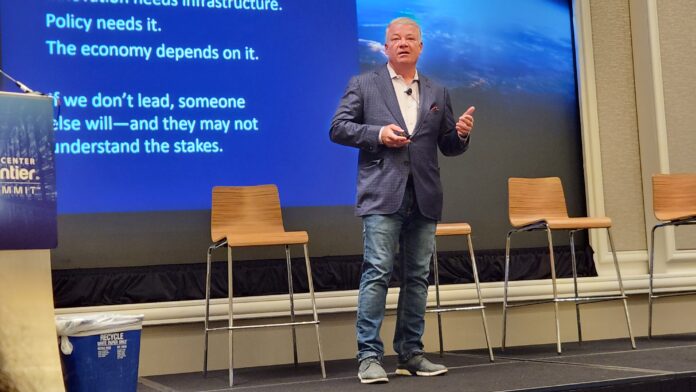Flexential CEO Chris Downie outlined a new playbook for data center operators, amid unprecedented demand, investment and chokepoints
RESTON, Virginia—The wake-up call for Flexential CEO Chris Downie started innocently enough: He sent a picture of himself meeting former Ukrainian heavyweight boxing champion Wladimir Klitschko to a friend, in which both he and Klitschko were smiling and good-naturedly flexing for the camera. Within 15 minutes, the friend sent back a brief video, seemingly of that same moment: The men grinned, flexed — then turned to each other, squared off and began sparring.
The sparring never happened. The video was AI-generated from Downie’s picture. But for Downie, the surreal experience of realizing that AI could turn his image into anything, create moments that looked real but were completely fabricated — and he had no control over it — was emblematic of just how far off the map that the data center industry, where he has spent two decades, was headed.
“The machines are re-writing reality in real time,” he told the audience at this week’s Data Center Frontier Trends Summit. “And if they could rewrite my face and the scene of which I’m in, in less than 15 minutes, what is it going to do to the industry?
“Clearly, AI is already rewriting reality. It’s moving markets and momentum that we haven’t seen before,” Downie continued. While some are framing the growth as just another cycle of boom-and-bust — and Downie took care to run through a number of the up-and-down cycles the data center industry has already weathered — he thinks this time is fundamentally different. “From my perspective, this isn’t temporary. And this is the moment that’s going to redefine our role as operators, as infrastructure enablers in the industry,” he said.
Data center operators have more or less followed the same playbook in past cycles, he said, tweaking and adapting based on lessons learned about things like power volatility and supply chain issues, with experience informing how new challenges would be approached. “But this new cycle invalidates past experience,” Downie said, adding: “As we look forward, we need to appreciate that everything’s different. And doing things business as usual, the same old way, isn’t going to apply.”
So what are the new rules for data center operators? Downie outlined the major industry touchstones that are being completely reshaped.
–Power needs. This is perhaps the most obvious crunch across the data center industry. Downie cited numbers from Reuters that indicated the average load from AI and data centers this year is projected to hit 488 gigawatts — the highest ever. Supply is not keeping pace, with annual demand outstripping utilities’ ability to provide. The gap between what the grid can provide and what data centers need could exceed 20 gigawatts by 2030, he warned, which creates cascading challenges for DC operators.

Those cascading effects include utilities shifting costs to data center operators in ways that they have not previously, and demanding up-front investment. “That was not in the old playbook,” he said. “So when you think about building substations or transmission lines, you now have to think about potentially hundreds of millions of dollars, in advance of deployment.” That used to be a cost that was amortized over time as part of the business model.
–Land getting locked up. Meanwhile, hyperscalers, and what Downie called “hyperspeculators”, are snapping up properties that could potentially serve as data center sites years out, or even a decade out, from any actual building plans. “That’s going to cause challenges for all of us. … We’re going to have to advance capital, to get land well in advance of when we ultimately needed to in the past,” he said.
–Build timelines keep stretching further and further out. In the old playbook, perhaps the timeline model was five years until a DC started generating return. Now, it might be longer than five years just to get the infrastructure built; in many cases, the wait time for power grid connections are exceeding seven years. If transmission projects are involved, the wait can be even longer. That level of delay, Downie said, may be “going beyond the horizons that are potentially set by the investors that are fueling the capital to drive our infrastructure.”
–Supply chains are stretched. Connection to power isn’t the only bottleneck. Critical equipment like distribution transformers can face lead times of up to five years, according to Downie. “That delay will impact even the best-prepared operators,” he said. “And we’re not talking about just transformers. You’ve got switch gear, generators, cooling systems … physical plant has become a strategic challenge. So, the new playbook will force us to think more dynamically about planning, procurement, and building than perhaps we’ve ever experienced in the past.”
–Constraints on elasticity. In the past, data center operators could assume that there was some predictable elasticity in supply, the supply chain, compute, talent and the basic raw materials needed for building and operating data centers. Things, and people, were available. They could be procured. That elasticity “isn’t available to us anymore. It really needs to be engineered,” Downie said.
–Infrastructure going from passive to pivotal. Digital infrastructure, Downie said, “has moved from the boiler room to the front lines.” That’s a new position for the industry. “For 17 of my 20 years in the business, data centers were in the background. Quiet, reliable, stable, but … in many ways behind the curtain.”
Now, it’s a strategic differentiator — “how innovation gets deployed, scaled, and monetized,” as Downie put it. That means the data center operators are moving from being essentially “order takers” to “innovation enablers.”
–Capital isn’t equally distributed, and costs are high. The common assumption is that the billions of dollars pouring into the data center market will address the demands of hyperscalers. But where does that leave the smaller enterprise customers who have filled data centers for the past two decades? Their needs aren’t going away, and they want to adopt AI tools as well — but now there is incredibly intense competition for data center resources. Downie said that he has had to decide whether to allocate data center capacity between two loyal Flexential customers, because there simply wasn’t enough for both.
“The enterprise needs to begin, if not continue already, to be thinking about how it thinks about elasticity in its own new playbook,” Downie advised. That means thinking about procurement timelines and being realistic about costs. In the new playbook, Downie sid, “Everything is expensive. Land, power, labor, patience. … All of these components are new currencies in the new playbook. And … none of us in this room, though, are in the business of absorbing costs to enable our customers’ growth.”
The new playbook is defined by scarcity
Amid the growth, he said, a variety of resources are being tested by scarcity. “We’re not just talking about megawatts,” Downie reflected. “We’re talking about land, power, community relations, touchstone talent — many of the raw materials that support the growth of the business.”
Flexential’s annual state of AI infrastructure report, based on a survey of 350 enterprises about their plans for AI, showed that survey participants are feeling more confident about AI than they were a year ago. “Things are definitely accelerating. … There’s high confidence that AI roadmaps need to be developed. But the interesting thing is that almost half of those enterprise IT leaders say that infrastructure is the greatest barrier to scaling AI.”
The Flexential CEO described the new environment as one defined by scarcity, where leaders will be judged by their ability to make hard trade-offs. He acknowledged having to prioritize capacity for one customer over another in recent months, a decision he never previously contemplated. “Scarcity is going to separate the leaders from the loud,” he said.
Despite the challenges, Downie remained optimistic about the industry’s future. He argued that infrastructure must not only keep pace with AI but also be recognized as “an engine of economic growth, national competitiveness, and innovation at a global scale.” Achieving that, he said, will require operators, policymakers, and enterprises to work together.

